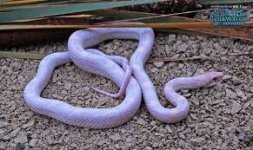Since I have looked up a few other cultivars, I might as well get this put somewhere safe before I lose all the descriptions I had on my SerpenCo.com website.
ADDENDUM: The area where I actually caught that wild cornsnake that was the original gene pool for the Lavender Corn was at an intersection of routes 41 and 771 in Florida near Port Charlotte at a spot called "Murdock". There used to be an old abandoned cement factory right there, and this female cornsnake was located underneath a piece of plyboard there. Now, that place is wall to wall strip malls, service stations, shops, and highways. If there were more gene carriers in that area, they are obviously long gone.
Lavender Corn Snake
This particular cultivar caused quite a bit of controversy a few (MANY!!) years ago. A particular broker/breeder(?) had been claiming that a line they were marketing as the 'Lavender' corn was a new gene, completely different from the 'Mocha' that I was currently working with. This bothered me quite a bit as this sort of information was not possible for anyone else to have. I had never sold ANY of my 'Mochas' knowingly before 1997. NO ONE else could have possibly bred a Mocha to this Lavender line to accurately be able to assess the relationship before at that time (1999). Except me. I bought a few pairs of the 'Lavender' line out of Pennsylvania from Jeff Yohe and bred them and the Mochas together. The results? ALL came out as the same homotype. An occasional amelanistic Lavender here and there, and once in a while an anerythristic, but nothing that would have surprised me. After all, one of the original ancestors of the Mocha/Lavender line was a snow corn.
As further evidence of that frivolous claim, I sent one of my male breeder 'Mochas' to Don Soderberg of South Mountain Reptiles to help him out of a bind when his male he got from that *other* source died on him. I also had in mind that this would be a good test by a non-biased party to breed a direct example from my line to the *other* line. In 2000, Don successfully hatched out one or more (I don't remember the number) babies from this breeding and proved conclusively that they were both the same genetic stock. As far as I am concerned, this matter is closed.
Well, back then, I at first resisted the idea of having my name of Mocha (actually coined by my wife based on the original hatchling in 1985, which was a light chocolate brown color) ursurped by the new marketing name being applied to my origination. But to be honest, 'Lavender' is a much more appropriate name and actually is more descriptive of what the adults look like. So swallowing my pride, I thought it best that I just drop the 'Mocha' name, and began calling them 'Lavenders' to help elimnate the confusion sure to develope. Unfortunately that step unleashed another firestorm, but that's another story. I will probably slip up every now and again and still refer to the line as 'Mochas', but for all intents and purposes, the name has been dropped.
The original Mocha hatched for me in 1985. It was a single surviving egg from a female that died eggbound and a male that I sold off before the egg hatched. Those parents were the result of breeding a snow corn to a wild caught female from an area of Florida between Sarasota and Punta Gorda captured in May of 1983. When this one animal hatched, I can remember thinking "Darn! Instead of getting an amelanistic, anerythristic, or a snow, I just get a normal-colored snake." That was before she shed her skin for the first time and I then noticed there was something unusual about her coloration. My original speculation was that this was just an odd manifestation of the Anerythristic gene, so my first breeding of this female was back to her grandfather (a snow corn) to see if it was, in fact, Anerythrism responsible for her odd color. Most of the babies hatched out as normals, with a few Anerythistics thrown in, which showed two things: (1) The 'Mocha' was NOT a form of anerythrism, and (2) she was heterozygous for Anerythrism.
Apparently, back in the late 80's, I sold off some normal colored animals that were carrying this unique gene. John Albrecht in Maryland purchased a number of my animals that exhibited partial stripes or aberrant patterns with the intention of trying to enhance this pattern abnormality. He was successful and produced a line called 'Zig-Zag' which was independent of the line being created by Bill & Kathy Love at the same time. Sometime while working on this project, John got some unusually colored animals to hatch out and subsequent discussions on the phone determined that they were probabably Mochas. We never did actually compare them side by side, but his description was enough to lead me to believe that was the case. It was not until 1996 that I finally was able to breed this line and my Mochas together to prove that they are, indeed, the same genetic line.
John eventually sold some of this Mocha blood line to some people in Pennsylvania, and this line has subsequently been called '<b>Cocoa</b>', '<b>Chocolate</b>', and '<b>Lavender</b>'. Dan Thomasco was one of the major players, I believe, in Pennsylvania providing the Lavenders. He, in turn, sold a lot of the Lavender stock to a gentleman by the name of Bob Scott in New Jersey, whom, in turn, sold animals to a certain party out west.
There seems to be quite a bit of variability in the coloration of this variety. They can vary from a pale lavender gray to a pastel dark lavender gray with a pinkish-orange wash over the background. Lately some have been hatching out with a decidedly purplish caste to them that I haven't yet identified the source of. The orangish coloration will peak when they get to be about 28 inches long, but will fade away in larger adults. Large adults appear to be a mostly lavender gray color with the pattern clearly defined. So far, all of the adults, regardless of whether they started out life as the light colored lavender ones, or the ones with substantial orange shadings, turn out looking basically the same.
One peculiar trait of this cultivar is that many will have a deep ruby red colored eye. Some are so dark that it is very difficult to see. As a matter of fact, I had examples of this cultivar for a couple of years and never noticed the eyes until Jeff Yohe pointed this out to me one day. It is very probable that this eye coloration is not directly linked to the Lavender gene, since some appear to lack the red eye color. It is VERY apparent in the hypo version of the Lavenders, producing a very interesting looking animal. But the ruby red eye trait is showing up in other cultivars, notably several lines of Ghosts, and although I have yet to track down a direct link, it is quite possible that they are the same influence. At this time, I don't know of anyone that has bred a Lavender with ruby red eyes to a Ghost with ruby red eyes to determine the outcome in the offspring.
Very often, other cultivars are mistakenly identified as being Lavenders. Most notably the Ruby-Eyed Ghosts, and Pastel Motleys. The Ruby Eyed Ghosts will normally lose the ruby eye as they reach maturity, and do not have the same shading that you will see in a Lavender. But without having one handy to compare side by side, it may be very difficult for someone inexperienced to be able to tell the difference. Pastel Motleys (Ghost Motleys) can very often have a rather Lavender wash to them and will often be mistaken for Lavender Motleys. At this time, there are so few Lavender Motleys existing that it would be rather unusual to find one available for sale, but certainly not impossible. I believe with experience, most people will be able to readily tell the difference, but with the lack of Lavender Motleys to use as a comparison, this experience will be hard to come by for a while yet.
Another cultivar that resembles the Lavender is a subset of examples of the Charcoal Ghost. Some of these can have a pale lavender sheen to the dorsal area. but it is not as pronounced as that seen in the Lavender. Again, a keen eye and experience will have to be your guide in this as there is no way to adequately describe the subtlety of colors in a text description like this.
ADDENDUM: The area where I actually caught that wild cornsnake that was the original gene pool for the Lavender Corn was at an intersection of routes 41 and 771 in Florida near Port Charlotte at a spot called "Murdock". There used to be an old abandoned cement factory right there, and this female cornsnake was located underneath a piece of plyboard there. Now, that place is wall to wall strip malls, service stations, shops, and highways. If there were more gene carriers in that area, they are obviously long gone.



